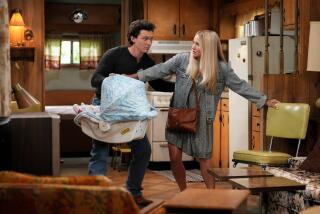Bart vs. Bill : ‘The Simpsons’ Faces a Tough Draw Against ‘Cosby’
- Share via
“The Simpsons,” Fox TV’s runaway hit, moves to its new Thursday time slot tonight, challenging NBC’s top-rated “The Cosby Show.” Both programs are repeats, and “The Simpsons” will remain in reruns until late October--a month after new episodes of “Cosby” start airing. Not an auspicious beginning for what many observers see as a David vs. Goliath confrontation.
Fox Entertainment President Peter Chernin insists that he is not out to topple “Cosby,” but to gain a toehold in weeknight prime time. At the recent meeting of the television critics, he announced:
“There’s no one in this company who looks at this as ‘Let’s take on “The Cosby Show.” ’ We think that if we’re really lucky and very fortunate we’ll come in second place to them because the other two guys (CBS and ABC) aren’t as strong. We’re hoping to establish a little bit of a foothold there.”
“We’re taking it as a very serious challenge, and I think that we probably will take a dent on Thursday night, certainly with the younger portion of the audience,” NBC Entertainment Chairman Brandon Tartikoff said in a recent speech. “My secret hope is that while we may lose something on the younger side, that we also may get three, four share points back from the 35-plus side of the equation. I wouldn’t mind ending up with the same share and rating as we ended the season with.”
The reason there won’t be any new episodes of “The Simpsons” until October lies in the program’s appropriately unconventional origins.
“Fox originally wanted a single special, but Jim Brooks and I said, ‘No, give us a series or forget it,’ ” said “Simpsons” creator Matt Groening. “I knew it would take a little while--not a long time, but a little while--for an audience to catch on to the program. So Fox ordered 13 episodes without a pilot, and we ran out. We were working on the next 22 before the first 13 were done, but it takes about six months to come up with and animate an episode because of the cumbersome nature of animation.”
Work on the next 22 installments of the irreverent cartoon is proceeding at a breakneck pace at the Clasky/Csupo studio in Hollywood, where five crews prepare five episodes simultaneously. The three-story gray building seems to overflow with artists and drawings, and additional space is being prepared in a second building down the block. Nine years ago, the Clasky/Csupo studio consisted of the apartment of the married founders, Arlene Clasky and Gabor Csupo.
Csupo, who serves as animation co-creative director on “The Simpsons,” was born in Budapest, Hungary, in 1952, and learned animation at the Pannonia studio there. In 1975, he and four friends obtained passports to Yugoslavia, then walked 2 1/2 hours through a dark train tunnel under the mountains to Austria and freedom, a journey he laughingly described as “quite an adventure.”
Csupo eventually made his way to Stockholm, where he scrounged free-lance animation jobs, but little work was being done in Sweden. He met designer Clasky while she was on a visit to Stockholm: She persuaded him to come to Los Angeles where he could find jobs more easily. Csupo emigrated in 1979, and the couple married later that year.
In 1981, they opened their own studio and began producing animated commercials and logos. The versatility of their output attracted the people at Gracie Films when they were looking for someone to animate the work of Groening and M.K. Brown for “The Tracey Ullman Show.”
“The great thing about Clasky/Csupo is that it’s not an animated sausage factory, cranking out several shows,” said Groening. “Their artists are young and eager to try to new things--they haven’t learned bad habits or been beaten down by the system. They bring an enormous enthusiasm to the work. I also think the studio offered to do the show for very little money.
“My characters are hard to draw. My drawing style is very flat, and I basically draw things in three-quarter profile. It was interesting for me to see how the characters look from behind, which I’d never been able to draw. We had to make certain decisions: Is the top of Bart’s head flat--or is it pointed like a meat tenderizer? We change our minds about the answers from time to time.”
The speed with which the original 60- to 90-second adventures of “The Simpsons” had to be made for “The Tracey Ullman Show” made it easy for the artists to change their minds. David Silverman and Wes Archer, who animated the segments, didn’t have time to make sure the characters were identical in every scene:
“Wes and I would look over each other’s shoulder and say things like, ‘Oh, you’re drawing Bart with nine points of hair? I’ve been drawing him with 10,’ ” said Silverman, who is now a director on the series.
“Matt’s characters don’t follow the normal construction of the Disney or Warners characters, which are based on circles and ovals,” he said. “Wes and I try to get the animators to think of them as puppets with cylindrical bodies, tubular limbs and wedge-shaped feet. It’s harder to draw a character designed in a two-dimensional style than one that’s intended for animation from the onset.”
Increasing production from 90 seconds to 30 minutes per week meant that the shows would have to be made like Saturday morning cartoons, with animation and ink-and-paint work done overseas.
“We had a lot of meetings about how to expand without overexpanding,” said Csupo. “We also did lots of research: Margot Pipkin, who was the producer at the time, and I flew to Asia and visited every studio personally. A lot of these places operate out of a two-bedroom house and hand everything out to free-lancers, so there’s no quality control. But we didn’t want to go to one of the big factory-like studios, either. We were looking for something in the middle that was efficiently set up, but not too big to handle our project with care.”
The contract went to Acom in Korea. Although all the people involved in the show praise the work of the Korean artists, problems invariably arise when the directors and animators are 8,000 miles apart.
“There’s a cultural gap that we’re not always able to bridge,” said Groening. “They sometimes animate the characters reading right to left, as they do in Korea, rather than left to right, the way we do here. Apparently, there’s a fruit in Korea similar to a banana, which is not yellow: When we had them animate bananas, they came out this very strange brown. We fix these things, but it’s cumbersome.”
Groening, Csupo and Silverman agree that the biggest challenge the animators face is finding a style of movement that’s appropriate to the characters’ designs and personalities. Silverman describes the animation of Bart and his family as “limited until they exert a lot of energy--they just wait for those moments to explode.”
“We had one dance sequence of Marge and Homer that was just too good,” said Groening. “It was a virtuoso piece of animation, but it was out of character for them to be such good dancers, so we had to clunkify it.”
In addition to “The Simpsons,” Clasky/Csupo continues to produce commercials, titles (“Quantum Leap,” “In Living Color”), rock videos (Luther Vandross’ “Here and Now”), trailers (“Die Hard 2,” “Nuns on the Run”) and concert films (“Terrifying” for the Rolling Stones). Their artists are working on the station breaks for NBC’s new Saturday morning lineup and a special that will air on HBO in October, based on Judith Viorst’s children’s book, “Alexander and the Terrible, Horrible, No-Good, Very Bad Day.”
When asked about the future of his studio, Csupo grows uncharacteristically serious:
“At this point, we’re being very selective about what we take on,” he said. “We turn down at least one show a week because the designs or the subject or the ideas don’t interest us. We just want to take it very slowly and do high-quality programs, either for prime time or Saturday morning. But if it’s for Saturday morning, I promise you whatever we do will be unlike anything that’s on, because Saturday morning is pretty much a disaster area.”
More to Read
The complete guide to home viewing
Get Screen Gab for everything about the TV shows and streaming movies everyone’s talking about.
You may occasionally receive promotional content from the Los Angeles Times.






